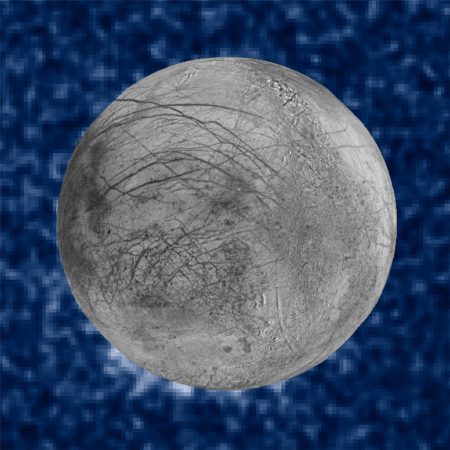December 5, 2017 – Europa is an ice moon circling Jupiter. It looks like a cue ball that has been scratched and marred over time. Icy plumes of water erupt from Europa’s surface from time to time giving us proof that what lies below is a vast amount of liquid water, an ocean in fact, with more water than on Earth. The presence of water has exobiologists wondering aloud if this moon is likely to harbour life.
Yesterday, researchers from Brown University, in Providence, Rhode Island, had their paper accepted for publication in the Journal of Geophysical Research. Entitled “Porosity and salt content determine if subduction can occur in Europa’s ice shell,” the paper tries to explain observed features on Europa seen in satellite, Hubble, and Earth-based telescope images. The moon bears surface scars that strongly resemble those found on Earth along the margins of continental and ocean plates. In running computer simulations of the moon’s surface features, the Brown researchers hypothesize that forces similar to plate tectonics are happening there. It’s not quite the same as what drives Earth’s plates, but the end result is the same.
Europa’s icy plates are moving and there is evidence of subduction zones where the moon’s surface ends up sinking into the ocean beneath. States Brandon Johnson, Assistant Professor, Department of Earth, Environmental and Planetary Sciences, and lead author of the paper, “If indeed there’s life in that ocean, subduction offers a way to supply the nutrients it would need.”
Tectonics on Earth results from the interaction between our lithosphere, consisting of pieces of the crust forming distinctive plates, and the viscous, hot mantle that lies beneath. As mantle currents cause upwellings we see eruptions occur along the plate edges. The eruptions add new material to the Earth’s surface and push apart the plate edges, while on other parts of the Earth pieces of the lithosphere get dragged beneath into the mantle in a process known as subduction.
On Europa, the equivalent to Earth’s lithosphere can be found on the surface containing an outer and inner layer of ice. The outer layer is very thin with the ice much colder than the layer beneath. It is this second layer which the researchers believe acts like Earth’s continental plates. But figuring out the mechanism is the unsolved mystery. What causes convection of the inner ice layer?
The researchers hypothesize that convection can be explained if the inner ice layer is saltier than the ocean beneath. And if saltier it must, therefore, be denser. The difference in density between ice and ocean then becomes the mechanism driving Europan tectonics with plates of ice akin to the continental plates that compose Earth’s lithosphere. And as on our planet, where subduction immerses pieces of the surface into the mantle, on Europa, a different chemistry and geology produce a similar effect.
The evidence for a denser, saltier ice surface is there states Johnson. Geyser-like plumes erupting from cryovolcanoes bring salt to the surface where it continuously accumulates creating these denser plates of ice and reinforcing the tectonic processes. Johnson notes that the ability to study plate tectonics on Europa may help us to better understand Earth’s plate tectonic processes and how they began in the early history of our planet. And even more exciting, is how this mechanism on Europa could provide the means by which life, if it exists there, can be sustained.
NASA scientists at the Jet Propulsion Laboratory in Pasadena, California, are hellbent on getting to Europa to further investigate it to determine if it could or is harboring life. A mission called the Europa Clipper is planned for as early as 2022. It will send a robotic spacecraft similar to Juno to enter into a series of long looping orbits around Jupiter aimed at repeated flybys of the moon. The instrument payload will include cameras and spectrometers to study the surface, and radar to map the subsurface ocean. A magnetometer will measure the moon’s magnetic field and help to determine the salinity and depth of the ocean. A thermal instrument will scan for cryovolcanic eruptions and other upwellings including water plumes first noted in 2012.
A future mission tentatively scheduled for the late 2020s proposes to put a lander on Europa’s surface in 2031 to search for evidence of life. It would have to touch down near cryovolcanoes or water plumes if it wants to find microbes or other evidence of life expelled onto the surface. Scientists speculate that life on Europa would be similar Earth life observed on our oceans’ floors in proximity to thermal vents called black smokers, or akin to the microbial life found in subsurface glacial lakes.
















